Frost-resistant onion "Batun" and features of its cultivation
Often on personal plots you can find a bunching onion: its beautiful large lilac flowers-balls adorn the flower beds. Onions are grown for greens, their tall tubular feathers have a delicate, mild taste that surpasses ordinary green onions.
When to clean and how to store, what are the benefits and harms of the onion, its photo, as well as other features - later in the article.
The content of the article
Description
The onion is a species of the genus Onion, grown as an annual as well as a perennial plant. Its aerial part is a bunch of tall tubular feathers. Biologists call the base in the form of a short stem a false bulb. The bloom of the batun occurs in the spring.
It is grown for greens. Propagated by seeds and dividing the bush into separate bulbs.
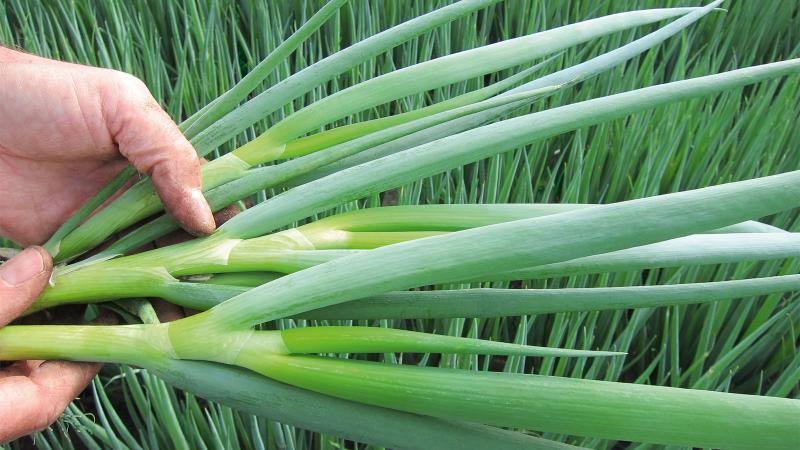
Varieties
Batun onions have a wide variety of varieties. Most often, early maturing, high-yielding varieties are grown in the open field:
- April - one of the earliest varieties. The plant is resistant to low temperatures and diseases. You can get 40-45 arrows from one bush.
- Russian winter - is grown before winter and spring. It tolerates well the conditions of the northern regions of the country.
- Tenderness - has a high yield. The greens are tender, soft in taste, contain a large amount of vitamin C, carotene.
- Emerald - an early ripe hybrid, resistant to cold temperatures, diseases and lodging. The taste is spicy.
- Red snowdrop - differs in frost resistance. The leaves are juicy and tender.
- Cipollino - an early variety with good disease and pest resistance. The leaves are juicy, slightly sharp.
Origin and development
Batun onion (Tatar, fisty, sand, Chinese onion) is a perennial herb of the genus of onions of the Amaryllis family. The homeland of onions is Asia. Grown in China, Japan. Currently, the batun is cultivated in all regions of Russia, except for the Far North.
Chemical composition and useful properties
The calorie content of onions per 100 g is 34 kcal. Also, 100 g of the product contains 1.3 g of proteins, 0.1 g of fat, 3.2 g of carbohydrates.
Vitamin content:
- B1 - 0.05 mg;
- B2 - 0.09 mg;
- B4 - 5.31 mg;
- B5 - 0.17 mg;
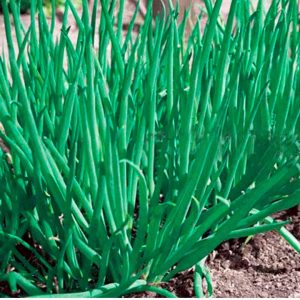
- B6 - 0.07 mg;
- B9 - 16.1 mcg;
- C - 27.1 mg;
- E - 0.52 mg;
- K - 192 μg;
- PP - 0.41 mg.
Macronutrient content:
- potassium - 211 mg;
- calcium - 19 mg;
- magnesium - 22.5 mg;
- sodium - 17 mg;
- sulfur - 18.7 mg;
- phosphorus - 48 mg.
Microelement content:
- iron - 1.23 mg;
- manganese - 0.14 mg;
- copper - 71 mcg;
- zinc - 0.51 mg.
Onions are used for dietary nutrition, used in folk medicine for diseases of the digestive system, diseases of the cardiovascular system, colds, to strengthen the immune system.
Batun is used as a diuretic, antihelminthic, hemostatic agent. Onion pulp strengthens hair, is used as masks for face and hands.
Ripening period and yield
Batun is characterized by early ripening. They begin to cut it off 30 days after the first shoots appear.
Depending on the variety, the yield is 6.5-15.5 kg per 1 sq. m.
Disease resistance
The culture has persistent immunity to many diseases and pests, but if the cultivation technique is violated, downy mildew may appear on the feathers.
Characteristics, description of appearance, taste
The aerial part of the onion is tall, tubular, green feathers that are hollow inside. Their length reaches 60-80 cm, width 1-2 cm. At the base of the batun, a short leg is formed, called a "false bulb", it is white, sometimes with a purple tint. The batun has no onion turnip. In terms of taste, the batun surpasses green onions, its pulp is softer and softer in taste.
Onion bloom occurs in spring, with small lilac flowers gathered in globular inflorescences.
For which regions is it best and what is the climate requirements
Batun is cultivated in almost all regions of the country with the exception of the Far North. Many onion varieties tolerate light frosts well.
Main advantages and disadvantages
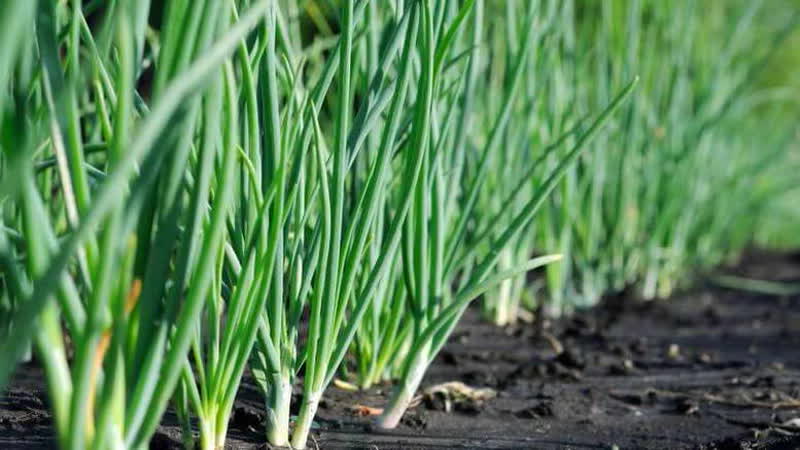
Onions have many advantages:
- it is a perennial, very productive crop: feathers can be cut up to three times per season;
- the ability to collect green feathers in early spring;
- undemanding care;
- high productivity;
- has medicinal properties.
Disadvantages of the view:
- lack of turnip onions;
- if you grow it for 4-5 years in one place, it will begin to shrink, arrows will appear, and taste will be lost.
What is the difference from other types of onions
- the feathers of the baton are more powerful, high;
- the bush consists of several stems, each with 4-6 feathers;
- the bulb is undeveloped, thin;
- the batun is less picky about lighting conditions, it can be planted in the shady part of the garden.
Features of planting and growing
The onion is grown in several ways: by sowing seeds, planting seedlings in open ground, dividing the bush into daughter bulbs.
Preparing for landing
Before sowing, the seed is soaked for two hours in warm water. During this time, high-quality seeds will sink to the bottom, unsuitable ones will float up - they are thrown away.
Good seeds are disinfected in a solution of potassium permanganate for 30-40 minutes. Then they are placed in a refrigerator for hardening for a day. After that, the seeds are sown in a container with prepared soil.
Ground requirements
The tramp grows well on sod, loamy, sandy loamy soils with neutral or low acidity. To deoxidize the soil, wood ash is added, black soil is added to the sandy soil.
Attention! Sandy, peaty soil is not used to grow the batun. In such areas, the bow goes into the arrow.
In autumn, the site is dug up with the introduction of organic matter and complex mineral fertilizers.
Timing, scheme and landing rules
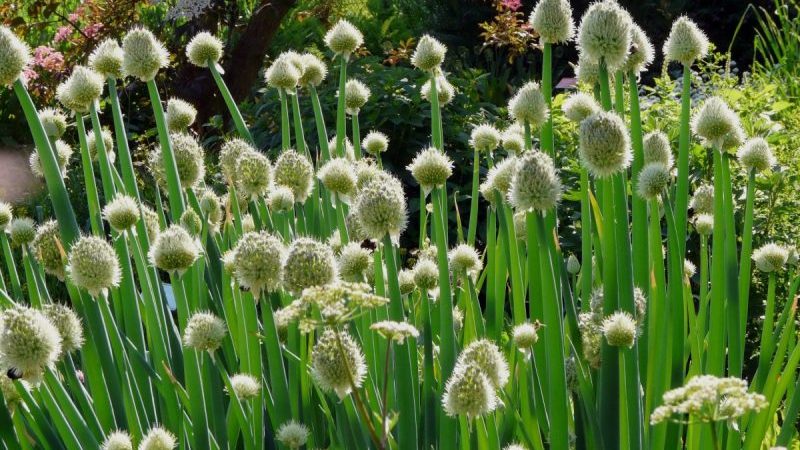
Seedlings are sown for seedlings in the first half of April.... The seeds are sown in a container with a substrate consisting of turf and humus (1: 1), grooves are made 1 cm deep.A 5 cm is left between them.The crops are covered with a small layer of soil, moistened with a spray bottle, covered with foil and placed in a warm place.
After the first shoots appear, the container is transferred to a well-lit place. For normal growth, they need 14 hours of daylight hours, so they need backlight.
Seedlings are periodically moisturized... Two weeks after the emergence of seedlings, they are fed with a solution consisting of 1 g of potassium nitrate, 1 g of superphosphate, 5 liters of water. When the first true leaf plate appears, the seedlings are thinned out, leaving a distance of 3 cm. A week before planting in open ground, the seedlings are hardened by placing them in fresh air with a gradual increase in hardening time.
In mid-June, seedlings are planted in open ground.In the prepared area, grooves are made 3-4 cm deep, the plants are planted at a distance of 3 cm, a gap of 20-25 cm is left between the rows.
Growing features
Batun onions are grown only for greens. When grown as a perennial plant, you can harvest for five years.
The nuances of care
At the end of June, the lower feathers are trimmed. The young top greens are left to grow further.
To transplant the onion to a new place, it is dug up, the bulbs are divided into several pieces and planted separately in a new place.
Reference. In autumn, the batun does not need care, as it goes into the sleep stage.
Watering mode
Watering crops should be done regularly and abundantly. The soil is moistened to a depth of 18-25 cm. In dry weather, the beds are watered twice a week. If dry weather persists for a long time, the culture is watered every other day with warm water under the root.
Important! When growing onions, drying out of the soil is unacceptable.
Loosening the soil and weeding
After each watering, the soil is loosened to prevent the formation of an earth crust and to allow air to reach the roots. Weed the plantings as weeds appear, which interferes with the normal growth of onions.
Top dressing
The first feeding of seedlings is carried out 10 days after planting in open ground, using organic matter: wood ash, compost, chicken manure solution.
Important! Feeding with chicken droppings is carried out once, since onion greens accumulate nitrates.
The second feeding is carried out after three weeks. Into the soil is applied 20 g of "Nitrofoski" per 1 sq. m.
During the growing season, onions need potassium and phosphorus. Potassium nitrate (15 g per 1 sq. M), superphosphate (20 g per 1 sq. M) are added to the soil. Top dressing is carried out three weeks after the second.
Disease and pest control
Batun is an unpretentious plant, but if cultivation techniques are violated, fungal diseases may appear on it.
Downy mildew (downy mildew) - manifests itself in the form of a gray-violet bloom on the green mass, leading to the death of the affected areas. High humidity in the beds should not be allowed - this provokes its appearance. In advanced cases, the onion is sprayed with a solution of copper sulfate.
Attention! Chemicals are used only in extreme cases.
Rust - appears as rusty spots on feathers that take the form of bumps. At the first signs of the disease, dusting with chalk is used. For severe lesions, spray with "Fitosporin-M", 1% Bordeaux liquid.
White rot - starts as a white bloom at the base of the stem. Then it moves to the leaves, leading to their death. For treatment, the plants are treated with the composition: 3 g of copper sulfate, 10 g of carbamide (urea), 1 g of zinc, dissolved in 10 liters of water.
Insects often appear on the batunpests: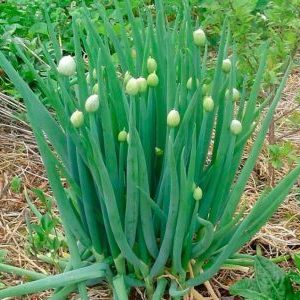
- Stem nematodes - small white worms that live inside feathers and feed on their sap. A sign of the appearance of nematodes is colorless spots on the feathers. For prevention, plants are sprayed with infusion of garlic, tomatoes, potato tops.
- Onion fly larvae - parasitize in the false bulb, eat out the core. Feathers turn yellow, wither. Onion flies are treated with saline three times per season (a glass of salt per 10 liters of water).
Harvesting and storage
Cutting of greens begins in the second half of July and continues until autumn. With long-term cultivation, feathers begin to be cut in the spring, one month after the appearance of green shoots.
Reference. The earlier the first greens are cut, the earlier the second crop is harvested.
The last pruning is carried out a month before the onset of frost.
How and when to collect
Final cleaning is carried out in the fall. When the feathers reach a height of 23-25 cm, they are cut at the level of the soil surface. At the same time, the bulb is not pulled out - it is left in the soil for further growth in the spring. The cut greens are tied in bunches, wrapped in cling film and placed on storage.
Storage features and keeping quality
For long-term storage onion washed, cut, packed in bags, containers and placed in the freezer. At the same time, greens do not lose their nutritional value for about a year.
In the vegetable compartment of the refrigerator, the onion is stored for about a month, retaining its presentation and taste.
Dried onions are stored for a long time. To do this, it is cut, dried, and then placed in paper bags and stored in a dry place. Dried batun is used as a spice for culinary products.
What can be the difficulties in growing
Onion-batun does not tolerate low-lying areas, in which water accumulates after rains. At the same time, the soil during cultivation should be constantly slightly moistened. Therefore, it is necessary to choose the correct watering regime for the full growth of the crop.
Tips from experienced gardeners
Experienced gardeners note that with thickened plantings, plants cannot fully develop. But if you reduce the distance between the bushes to 5 cm, the green feather will be slightly thinner and softer.
Experienced summer residents advise planting a trampoline on a site where legumes, cabbage, and tomatoes grew before. It is not recommended to plant a crop after garlic, cucumbers, carrots.
Experienced gardeners recommend covering the plot with onions with a film for the winter - in the spring you can get the harvest two weeks earlier.
Reviews of the onion-batun
Most of the reviews about onions are left by hostesses who use it as a seasoning.
Elena, Moscow region: “A neighbor shared a freshly cut bunch of spring onions. I was surprised by its taste - it is completely unlike ordinary green onions, soft, tender, without bitterness. I liked it very much.
Oleg, Saratov: “I have been growing a batun for several years by dividing bushes. From spring to autumn I constantly cut fresh feathers for food, new ones grow quickly. The onion grows without problems, does not require special care. "
Maria, Omsk: “I got onion seeds out of interest at a nice price - 5 rubles. per pack. Sowed in the spring, two months later it was already planted with a delicate unusual taste of feathers. I noticed that if you cut them regularly, the feathers do not coarse. "
Conclusion
The onion is gaining more and more popularity among summer residents and farmers due to its unpretentiousness, ability to grow in various climatic conditions. Green onions eat from early spring to autumn.
The beneficial properties of the batun are due to its rich composition. This type of onion is widely used in folk medicine and cosmetology.